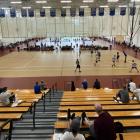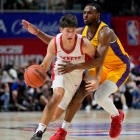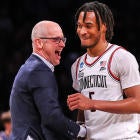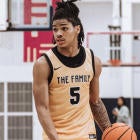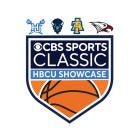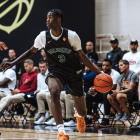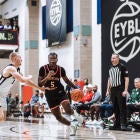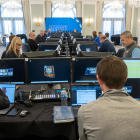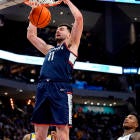
AVON, Conn. -- Sneakers squeak, whistles tweet and the bellowing of voices ricochet off three-story-high walls.
Things are not all the way back to normal, but this is quite a welcomed environment for the basketball lover's soul. A three-court setup inside the spacious gymnasium at Avon Old Farms School was the site of the 2021 New England Prep School Athletic Council (NEPSAC) showcase, a three-day recruiting event held over the weekend that signaled a return to college basketball's in-person recruiting calendar.
The NEPSAC showcase was one of dozens like it held across the country in the final two weekends of June. Coaches drove, flew and flocked to gyms and hoop halls across the United States to finally get their eyes on prospects they'd been recruiting for more than a year -- without ever seeing them play in person. The previous 15 months saw most of the sport's norms perverted because of COVID-19. Talk to almost any coach and they'll tell you the most disruptive (but necessary) action was the NCAA's ban on in-person recruiting. Specifically: live evaluations of players playing games. Without the ability to scout, most coaches felt like they were not getting the full picture on players they were chasing. And in many cases, that's true.
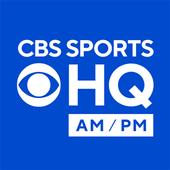
CBS Sports HQ Newsletter
Your Ultimate Guide to Every Day in Sports
We bring sports news that matters to your inbox, to help you stay informed and get a winning edge.
Thanks for signing up!
Keep an eye on your inbox.
Sorry!
There was an error processing your subscription.
Hopefully, that period is over for good.
"This is great," Notre Dame coach Mike Brey said. "I went to an event last weekend and I'm looking around, talking to other guys saying, 'How lucky are we?'"
The NCAA's prohibition on all in-person recruiting, visits included, ended in early June. And here, tucked deep in the woods of Avon -- a tony town 15 minutes west of Hartford -- the NEPSAC showcase proved to be June's biggest event. It featured 60 teams, 554 players and 90 games. A few potential five-star players were on hand, notably 2023 prospect Matas Buzelis and 2022 power forward Kyle Filipowski. There were 316 college coaches who attended the event, according to Doug Scott, NEPSAC board member and a man who looked as happy as everyone else to have games, recruiting, camaraderie -- all of it -- back.
"I feel that the college prospect/college program process that we go through every year is maybe the most flawed important process that I've come across in my life," Scott said. "One of the biggest contributors to that is flawed information flow, so anything that can be done to improve that is a good thing. I'm thrilled to have our work help alleviate that lack of info flow by getting players in the gym with coaches."
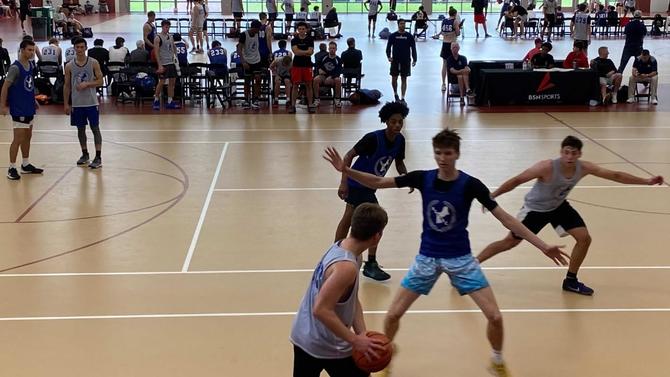
July will bring even bigger events and more attention, but June was an important tuneup. The past two weekends featured recruiting events with defined scholastic affiliation for all teams playing. The conceit debuted in 2019 as part of the NCAA's reorganization of the recruiting calendar. At that time, the change was met with spiky criticism by some coaches. Then the pandemic hit. Now everyone's grateful to be able to see players at all. Minnesota coach Ben Johnson and Boston College coach Earl Grant just got to their news posts in March. As first-year captains at those schools, both told me that seeing prospects in person is vital to long-term sustainability as a head coach, especially having just taken the job.
"We have to make sure our evaluations are accurate," Johnson said, and better for him to have gotten the job in 2021 as opposed to 2020, when none of this was an option.
Grant, who spent the past seven seasons coaching Charleston, is someone with an esteemed reputation for evaluating players.
"I can't miss on guys," he said, noting the wiggle room on his first recruiting class at a school like Boston College -- where the Eagles are always going upstream in the ACC -- is minimal.
The days of Zoom recruiting and doing everything exclusively over FaceTime are fading. While working the transfer portal has become nearly as important as treading the recruiting trail, most coaches still believe that being in the gym to evaluate high school sophomores, juniors and seniors is the steadiest path to building a stable program.
"Getting 316 coaches in the same room with 554 student-athletes, playing with and against other college-bound talent, is about as efficient (of a) way as possible to advance the matchmaking process," Scott said.
Double-edged sword for players
COVID shutting down in-person evaluations for more than a year meant lost opportunities for thousands of players to make a name for themselves, to earn scholarship opportunities. For other, more talented players who graduated high school in 2021, the eradicated 2020 period meant zero exposure that otherwise could have led them to play at bigger programs. But now, with the live period back, high school prospects can be hurt just as much as they can be helped.
We'll start with the good.
Take Avery Brown, a 17-year-old rising senior from Bridgeport, Connecticut, who plays for Massachusetts-based prep school Northfield Mount Hermon. The last time he played in front of college coaches was March 2020.
"Friday and Saturday I didn't have the best games at all, really," Brown said. "I wasn't playing like myself, to be honest. The first couple of days I was disappointed in myself. I didn't play my best. I don't know if it was the coaches being here to see me play, or just being in my head a little bit."
But Brown looked good Sunday -- by far the lightest-attended day of the three -- helping his team to a 30-point win. Sixteen months ago Brown held offers from four schools: Brown, Penn, Yale and UMass. He was able to improve his stock in the spring and summer of 2020 thanks to training and videos. Just last week he took an official visit to Nebraska. Arizona State and Virginia Tech recently offered him scholarships as well, as have a handful of Big Ten schools. Brown is ranked No. 132 in the 247 Composite, and he'll play in July with PSA Cardinals, a grassroots program, at the ballyhooed Nike EYBL event in North Augusta, South Carolina. A big opportunity for him awaits there, just as it does for Chase Ross, a combo guard who, as of this story's publishing, is a no-star recruit. Yet Ross, who hails from Dallas and attends Cushing Academy in Ashburnham, Massachusetts, seems poised for a big July.
Ross said he had nerves at the NEPSAC showcase because it was just the fifth organized game he played in more than a year. He played well, particularly on Friday: 21 points, six rebounds, four assists and a couple of steals in a win.
"I didn't know how I was going to play because I hadn't played a basketball game in so long," Ross said. "I didn't know if I was going to be huffing and puffing two minutes after the game starts. It went well. I paced myself and tried to do the best I could."
After playing in front of dozens of coaches for the first time in 23 months, Ross received six scholarship offers by the end of the weekend. His college trajectory changed in a significant way thanks to the NEPSAC showcase. Next, he'll play with Drive Nation in the EYBL. And now Marquette, Kansas, Kansas State and Virginia Tech are all showing heavy interest (but no scholarship offers yet).
And yet, Ross and Brown don't reflect the reality of what every player went through over the weekend. Some of them probably still don't realize it. A half-dozen coaches I spoke with -- and who were granted anonymity because of the sensitivity of the issue -- admitted that in-person evaluations are so helpful because of everything they provide. That means the good and bad. A common realization surfaced once these coaches plunked down in their seats to watch these games: This guy isn't good enough.
Mistakes were made.
Turns out that relying solely on workout videos, old game tape and the words of prep or grassroots coaches isn't an unfailing strategy. As every coach I spoke with told me: tape cannot replicate, or provide absolute truth, to what your eyes see with the live experience. The fact is, some prospects who are holding scholarship offers from big schools no longer really have those offers.T
They just don't know it yet.
They'll learn soon enough, as coaches will wean off communication, if not ghost a kid altogether. But that's just the way this game is played; the same thing happens when a player being recruited by a smaller school starts to attract legitimate attention from bigger programs. The mid-major is quickly left at the alter.
June sets the stage for July. And July will arrive with gobs hype and anticipation. It's the month where many dreams materialize and future basketball stars, in their infancy, truly ignite their origin stories. Winning programs are built here, in the summer, in the gyms, where logoed-up coaches do their best to recruit the best. It's on the players, too, and in some ways the field has never felt more level than now, with so much unknown still being worked through as the country is still living through pandemic.
But the gyms are open, the games are back. At the heart of it, that's all everyone really wants.








